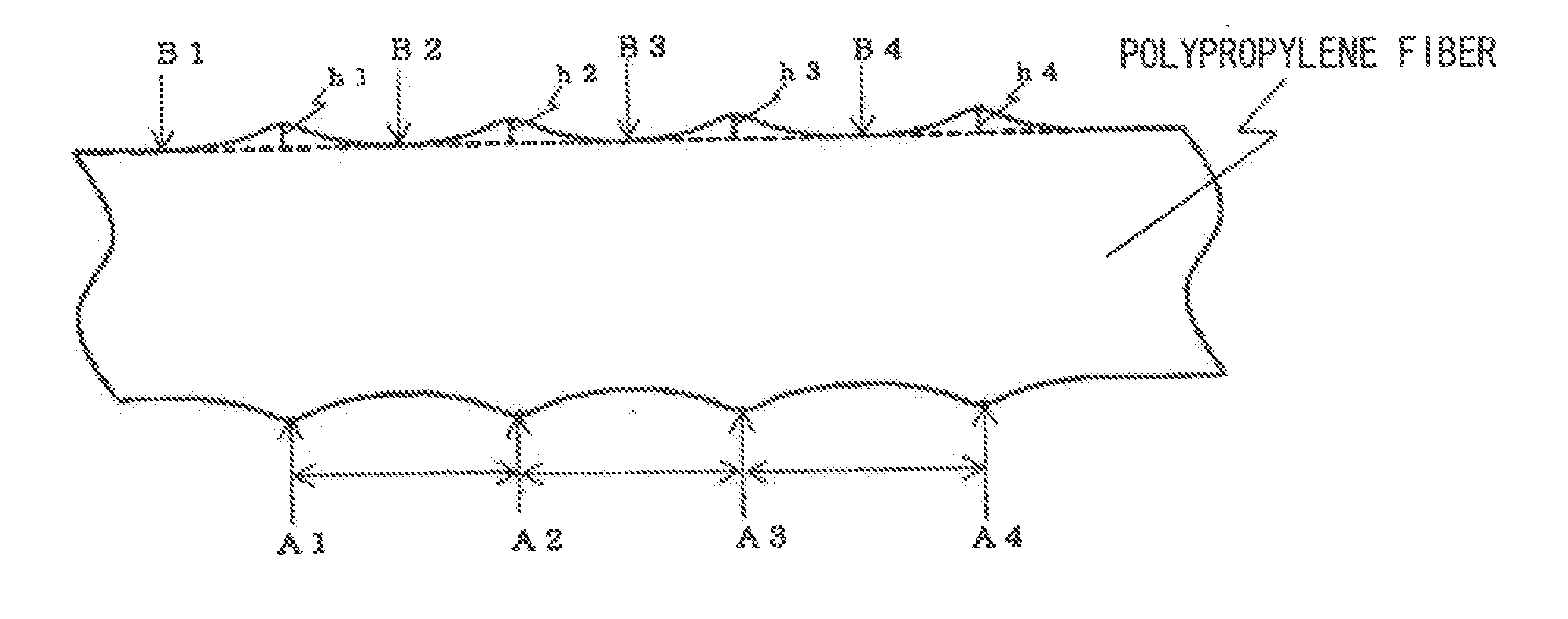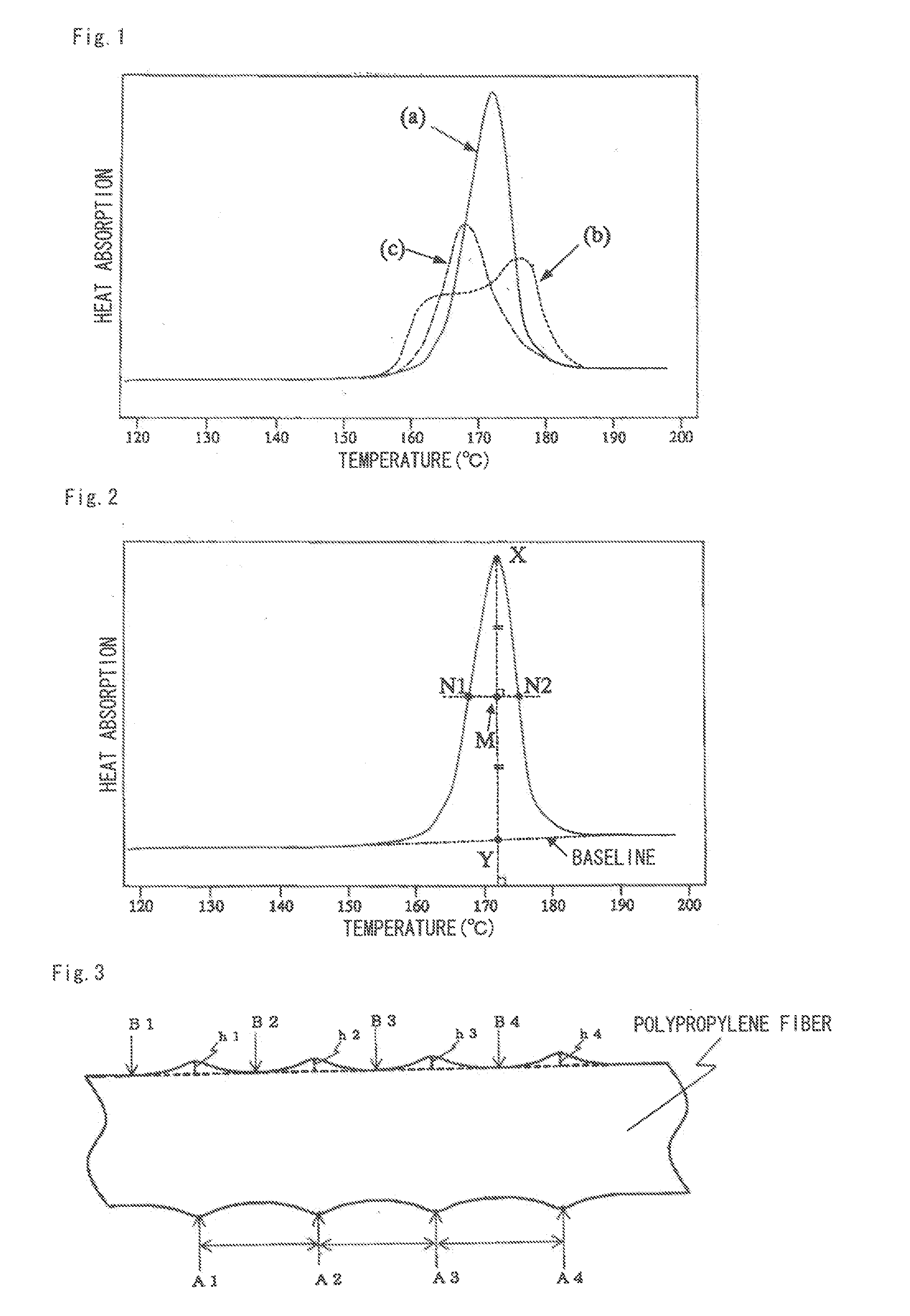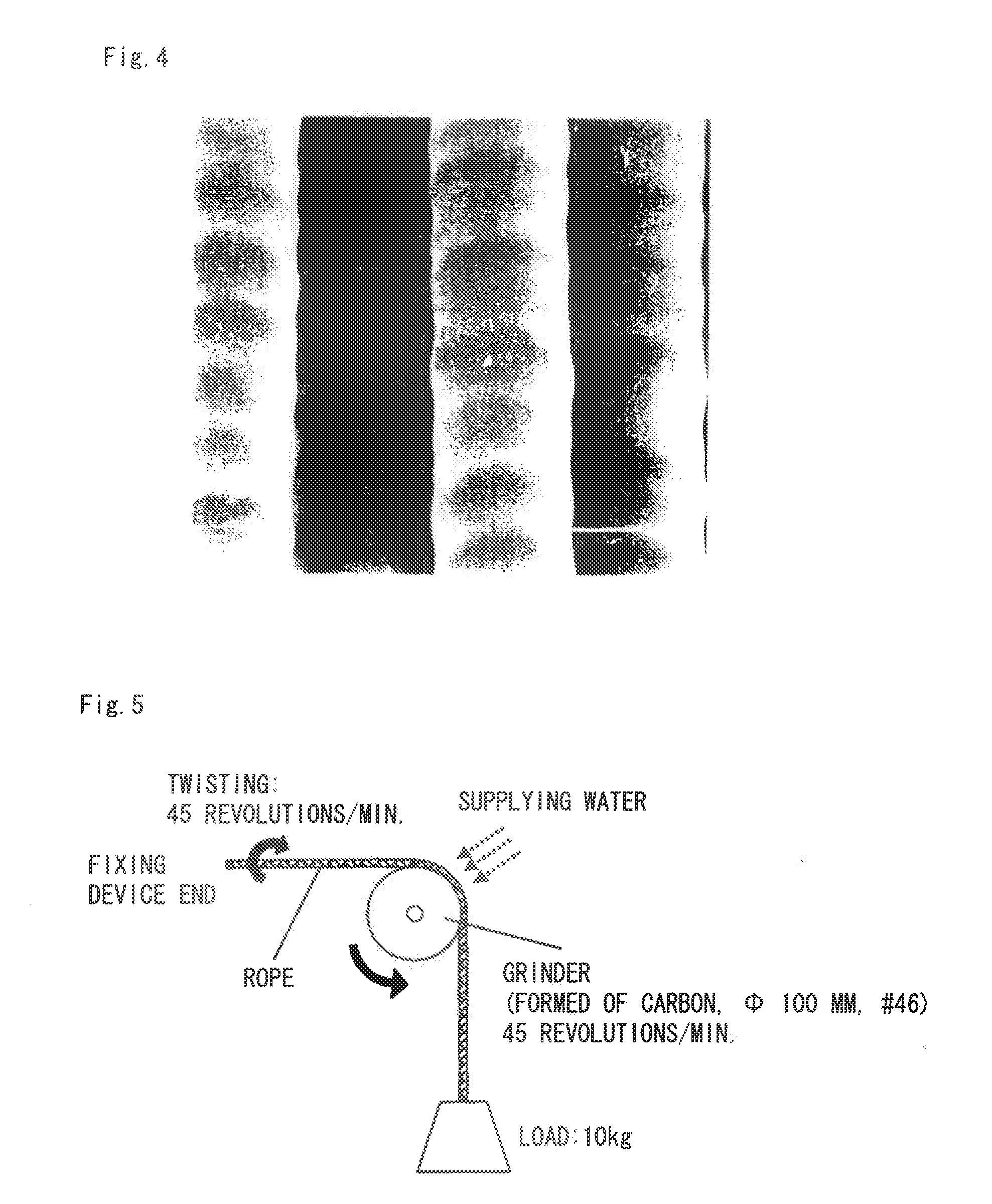However, the heat resistance of the polypropylene fiber is not sufficiently high among synthetic fibers, and therefore improvement in the heat resistance has been demanded.
However, due to poor heat resistance of the polypropylene fiber, the
polyolefin cannot be melt at a high temperature to be formed into a sheet at the time of producing the fiber-reinforced sheet.
Therefore, the
production rate cannot be increased, and moreover, the adhesion between the polypropylene fiber and the
polyolefin sheet is insufficient, resulting in reduced productivity, insufficient strength of a fiber-reinforced
polyolefin sheet to be obtained, etc.
However, the endothermic peak shape of the polypropylene fiber is a broad double shape or a single shape and the crystals thereof are not uniform.
Thus, the heat resistance thereof is not yet sufficiently high.
However, in the polypropylene fiber, the endothermic peak at a lower temperature among the two DSC endothermic peaks serves as an index of the heat resistance of the polypropylene fiber, the endothermic peak shape is broad, and the crystals thereof are not uniform.
Therefore, the heat resistance thereof is not sufficient.
Moreover, the polypropylene fiber is a widely used
synthetic fiber applied to various industrial materials, and the hydrophobicity poses a problem in many applications.
However, because the polypropylene fiber is hydrophobic and has a poor hydrophilicity, the polypropylene fiber, as it is, is hard to apply to paper, a
nonwoven fabric, a reinforcement material, etc., which require hydrophilicity.
However, in the case of employing the method, polypropylene, to which particles have been added, is subjected to
spinning and drawing, which makes it impossible to avoid influences on
spinning property and drawing property.
Thus, a polypropylene fiber having a sufficient strength cannot be obtained.
However, those methods are applied to a polypropylene fiber having a large
fineness, i.e., a
single fiber fineness as high as 50 to 100,000 denier, and are difficult to apply to a polypropylene fiber having a small fineness, i.e., a
single fiber fineness of 10 dtex or smaller, because the fiber is seriously damaged.
However, when the method is applied to a polypropylene fiber having a single fiber fineness of 10 dtex or lower, and particularly 3 dtex or lower, the strength is reduced, fluffs are frequently generated, unevenness in the form is noticeable, and there arise problems in the process passing property, quality, and grade.
However, in the polypropylene fiber, the intervals between the striated rough-surfaced structures that exist on the fiber surface and the height thereof are small.
Therefore, the fiber does not have sufficient water retentivity and the compatibility with a matrix is insufficient.
However, in the polypropylene drawn
yarn (polypropylene fiber) obtained by the method, the formation of irregularities on the fiber surface is insufficient, the intervals between the irregularities and the height thereof are small, the fiber does not have sufficient water retentivity, and the compatibility with a matrix is insufficient.
Moreover, a hydraulic product formed by hydration-curing (hereinafter sometimes referred to as “water curing”) of a hydraulic composition containing hydraulic substances such as
cement,
gypsum, and water-granulated
slag, has generally a low strength and is likely to develop cracks at the time of
drying shrinkage.
However, at present, a polypropylene fiber for reinforcing a hydraulic substance which has a
high heat resistance such that the fiber is resistant against
autoclave curing, high strength, and excellent compatibility with a hydraulic substance such as
cement, has not yet been obtained.
However, in the polypropylene fiber obtained in
Patent Document 1, the endothermic peak shape is a broad double shape or a broad single shape, the crystals thereof are not uniform, and the heat resistance is not yet sufficiently high as described above.
Therefore, the polypropylene fiber of
Patent Document 1 is not suitable for
autoclave curing at a high temperature, particularly at a temperature exceeding 150° C., and more particularly at a temperature as high as 170° C. or higher.
When the polypropylene fiber of
Patent Document 1 is subjected to
autoclave curing at a high temperature, the reduction in the strength, degradation, etc., of a polypropylene fiber are likely to occur.
Thus, the compatibility of each of the polypropylene fibers with a hydraulic substance is likely to become insufficient, and moreover, in order to uniformly disperse the polypropylene fibers throughout a hydraulic substance for sufficient reinforcement, a large amount (large
mass) of the polypropylene fibers needs to be blended.
Moreover, when the methods of forming irregularities described in Patent Documents 4 to 6 are applied to a polypropylene fiber having a fine size, i.e., a single fiber fineness of 10 dtex or smaller, the fiber is remarkably damaged.
Thus, it is actually difficult to apply the formation methods to the polypropylene fiber having a fine size.
Of those, the polypropylene fiber described in Document 4 has a large fineness and is difficult to exhibit sufficient reinforcement effects to a hydraulic substance.
However, as described above, because the polypropylene fiber does not have sufficient water retentivity, the compatibility with a hydraulic substance is insufficient.
However, as described above, in the polypropylene drawn
yarn (polypropylene fiber) obtained by the method of Patent Document 8, the formation of irregularities on the fiber surface is insufficient, the intervals between the irregularities and the height thereof are small, and the polypropylene fiber does not have sufficient water retentivity.
Therefore, the compatibility with a hydraulic substance forming a matrix is insufficient.
However, among synthetic fibers, a heat resistance of the polypropylene fiber is not high.
This is because, when the rope formed by using the polypropylene fiber is exposed to a high temperature or subjected to frictional heat at the time of
rubbing or
scratching, the polypropylene fiber forming the rope melts, causing, for example, meltdown of the rope, which results in that physical properties such as strength are likely to decrease and the drawing of the rope under a high temperature is high.
However, in the polypropylene fiber, the crystals are not uniform and the heat resistance is not yet sufficiently high.
Therefore, even when a rope is formed by using the polypropylene fiber, meltdown and reduction in physical properties due to frictional heat or the like are likely to occur.
Thus, the drawing at a high temperature is likely to become high.
However, with a rope formed of a conventional polypropylene fiber, slipping between polypropylene fibers and slipping between polypropylene fiber strands are high, and it is difficult to sufficiently firmly and tightly twist the fibers.
However, in a conventionally known polypropylene fiber on the surface of which irregularities have been formed and a polypropylene fiber whose surface has been roughened, the irregularities (surface roughened) are insufficient and the formation of irregularities is regulated.
Even when a rope is formed using the polypropylene fibers, it is difficult to tightly and firmly twist the polypropylene fibers (polypropylene
yarn and strand).
Therefore, the anti-slip effect between fibers is insufficient, and even when the polypropylene fiber is applied to production of a rope, the fibers are not tightly and firmly twisted.
Thus, a rope which is excellent in mechanical properties, wearing resistance, untwisting resistance, shape retentivity, etc., cannot be obtained.
Further, with respect to the polypropylene drawn yarn (polypropylene fiber) described in Patent Document 8 mentioned previously, the formation of irregularities on the fiber surface is insufficient and the intervals between the irregularities and the height thereof are small.
Therefore, the anti-slip effect between fibers is insufficient, and even when the polypropylene fiber is applied to production of a rope, the fibers are not tightly and firmly twisted.
However, since the heat resistance of the fabric formed of a polypropylene fiber is insufficient, the polyolefin sheet base cannot be melted at a high temperature, which causes the reduction in productivity, lack of
adhesion strength between the fiber formed of a polypropylene fiber and the polyolefin base, etc.
However, in the polypropylene fibers described in Patent Documents 1 and 2, the crystals are not uniform and the heat resistance is not yet sufficiently high.
Thus, a sheet-shaped
fiber structure excellent in heat resistance cannot be obtained.
However, due to poor hydrophobicity, the synthetic paper and the
nonwoven fabric formed of a polypropylene fiber, as they are, are difficult to be applied to an aqueous
filtration and an alkali secondary battery separator that require high hydrophilicity.
However, the polypropylene fiber has insufficient strength, and thus, sufficient strength cannot be obtained when formed into a sheet-shaped fiber structure such as a woven knitted fabric, a
nonwoven fabric, a synthetic paper, and a net-like article.
This is because the irregularities (surface roughened) are insufficient, so the formation of the irregularities is limited, and because the strength of a polypropylene fiber itself is low.
Therefore, even when a sheet-shaped fiber structure is formed using the polypropylene fiber, a sheet-shaped fiber structure excellent in strength cannot be obtained.
Thus, even when the polypropylene fiber is used, a sheet-shaped fiber structure excellent in water retentivity cannot be obtained.
Further, with respect to the polypropylene fiber described in Patent Document 8, the formation of the irregularities on the fiber surface is insufficient and the intervals between the irregularities and the height thereof are small.
Thus, even when the polypropylene fiber is used, a sheet-shaped fiber structure excellent in water retentivity cannot be obtained.
However, because the heat resistance of the polypropylene fiber is insufficient, the productivity decreases and the
adhesion strength between the polypropylene fiber and the polyolefin base is insufficient as described above.
Moreover, when the polypropylene fiber is used as a reinforcement fiber for organic polymers other than polyolefin to produce a composite material containing the polypropylene fiber and an
organic polymer and a molded product, a sufficient reinforcement effect is sometimes not acquired due to low heat resistance of the polypropylene fiber and low adhesiveness of the polypropylene fiber to the organic
polymer.
However, the heat resistance of each of the polypropylene fibers described in Patent Documents 1 and 2 is not yet sufficiently high.
Thus, the polypropylene fibers described in Patent Documents 1 and 2 are not necessarily effective as the reinforcement fiber for organic polymers.
Further, with respect to the polypropylene fibers having irregularities on the surface described in Patent Documents 4 to 8, the irregularities on the surface (surface roughened) are insufficient, the formation of irregularities is regulated, and the strength is insufficient.
Therefore, even when these polypropylene fibers are applied to a reinforcement fiber for organic polymers, it is impossible to obtain a composite material containing an organic
polymer and the polypropylene fiber, a molded product, etc., which are excellent in strength and the like due to insufficient adhesion with organic polymers.
 Login to View More
Login to View More 


